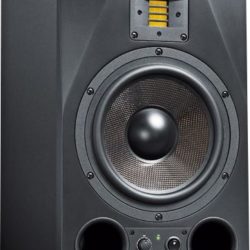Compact yet powerful suitable for both nearfield and midfield monitoring
With its power and radiation characteristics, the ADAM Audio A8X Powered Monitor is suitable for both nearfield and midfield monitoring. With a price/performance ratio that could hardly be better, this monitor is a perfect entry into these monitoring fields.
The A8X is equipped with the X-ART tweeter and a large (8.5″) midwoofer, a combination that adds both a very deep and yet very tight bass response to the unsurpassed reproduction qualities of the ADAM proprietary tweeter: a licence to thrill.
Cabinet- and bass reflex-construction
Like the other AX-Series models, the upper corners of the A8X are slanted to minimize reflections. The very large, double bass reflex tubes on the front have been specifically designed to perfectly match the midwoofer with its large voice coil.
Amplification and controls
With a 50W A/B amplifier for the tweeter and a 150W PWM amplifier for the midwoofer, the A8X has power in abundance and is the brawny monitor of the AX-Series.
On the rear panel are several controls: a gain for the high frequencies (± 4dB) and two shelf filters for the high and low frequencies. There are both XLR (balanced) and RCA (unbalanced) connectors on the rear panel of the speaker, which allow the A8X to be used in almost any application.
X-ART Technology
The X-ART (eXtended Accelerating Ribbon Technology) tweeters and midranges incorporate a new approach to the Air Motion Transformer concept originally developed by Dr. Oskar Heil. ADAM Audio has improved upon this splendid idea utilizing superior geometries and materials to achieve unprecedented audio fidelity. X-ART strikes a new path concerning the kinematics of moving air, resulting in a dramatic improvement in the quality of audio reproduction.
The X-ART membrane consists of a pleated diaphragm in which the folds compress or expand according to the audio signal applied to them. The result is that air is drawn in and squeezed out, like the bellows of an accordion.
The ADAM X-ART design overcomes the piston-like motion of all conventional drivers and their inevitable problems by achieving an improvement in air loading by a factor of 4 over conventional transducers. To illustrate the basic principle by a comparison: When you breathe, your thorax is moving slowly whereas the air is moving comparably fast. Similarly, the X-ART diaphragm presses the air faster in or out of its folds than they themselves are moving. This markedly superior â€motor†is responsible for the unprecedented clarity and pristine transient reproduction that can be heard with the ADAM X-ART drive units.
In addition, the X-ART tweeter’s pleated membrane avoids the typical breakup/distortion and subsequent dynamic limiting at higher frequencies of stiffer voice coil designs, such as those found in dome and cone tweeters. Another positive result of the X-ART design is that the driving â€stripes†are in direct contact with the outer air and are cooled immediately.
Pulse Width Modulation
PWM (Pulse Width Modulation) – sometimes referred to as Class D amplification, sometimes called Switching Amp Technology – converts the incoming signal to a series of rectangular waveforms of equal height. The width of the rectangles varies in time and the relation of the width of the rectangles represents the musical signal. This waveform can be amplified much more simply, as the transistors are not modulated anymore; instead they are used as switches that only turn the power supply voltage on and off.
It is possible that a very fast mechanical switch could do the job, but power transistors are a better choice for the task, so PWM amplifiers still work pretty much like conventional Class AB designs. It is important to note there are no bits and bytes involved, so “Digital Amplifier†is a misleading and inaccurate term.
The main advantage of PWM amplifiers is their extremely high efficiency (>90%). As a consequence the heat to be dissipated is only one fifth of earlier designs, leading to much lower temperatures within the amps and making the use of heat sinks obsolete.
This principle has been known for decades, but time was needed to develop units that perform at the leading edge in sonic reproduction quality and yet still maintain the high efficiency mentioned previously. The ADAM units use the new technology for both the amp and the power supply section (i.e. no more transformers) combined with state of the art input and filter sections to achieve the best in multi-channel active studio monitoring.






Join the discussion
comments powered by Disqus